Peter Lobner, updated 19 December 2023
1. Introduction
Uranus, the seventh planet from the Sun, is an ice giant planet with 27 known moons in a unique orbit beyond Saturn. Uranus makes a complete orbit around the Sun in about 84 Earth years. It is the only planet whose equator is tilted nearly at a right angle to its orbital plane, which results in the polar regions pointing toward the Sun (and Earth) during parts of the orbit.
Uranus was visited briefly by NASA’s Voyager 2 spacecraft during its January 1986 flyby, which came within 81,500 km (50,600 miles) of the planet’s cloud tops. Since then, Uranus has been studied at visible, near-infrared and X-ray wavelengths from the perspective of terrestrial and near-Earth, space-based observatories.
Visible light has a wavelength in the range from about 350 to 750 nanometers (nm, 10-9meters) or 3,500 to 7,500 Angstroms. Near-infrared light is the part of the infrared spectrum that is closest to the visible light spectrum, but at a longer wavelength, from about 800 to 2,500 nm. X-rays have a much shorter wavelength, from about 20 to 0.001 nm. In the following chart, you can see the relative placement of visible and near-infrared light and X-rays in the electromagnetic spectrum.
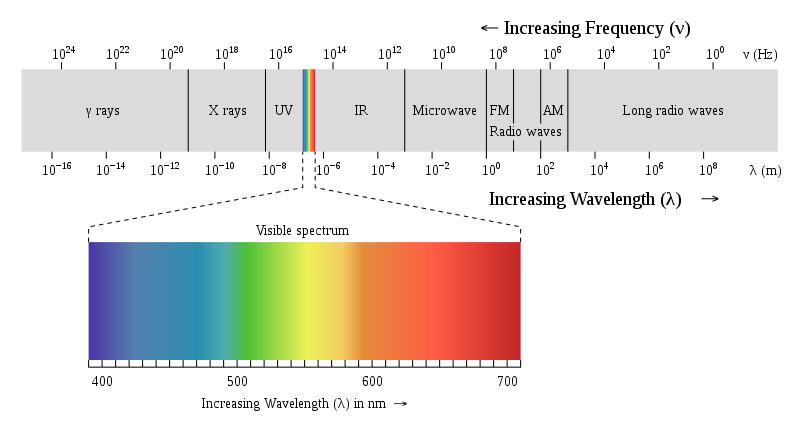
2. 2021 composite images of Uranus at visible / near-infrared and X-ray wavelengths
In March 2021, the National Aeronautics and Space Administration (NASA) announced that its orbiting Chandra X-ray Observatory had made the first ever detection of X-rays coming from the ice giant planet Uranus. Recent analysis of Chandra observations from 2002 and 2017 resulted in this discovery. You can read NASA’s 2021 announcement of this discovery here: https://chandra.si.edu/photo/2021/uranus/
X-rays coming from other planets have been detected in the past. NASA reported, “Like Jupiter and Saturn, Uranus and its rings appear to mainly produce X-rays by scattering solar X-rays, but some may also come from auroras…… The X-rays from auroras on Jupiter come from two sources: electrons traveling down magnetic field lines, as on Earth, and positively charged atoms and molecules raining down at Jupiter’s polar regions. However, scientists are less certain about what causes auroras on Uranus.”
Another possible X-ray source could be from an interaction between Uranus’ rings and the near-space charged particle environment around the planet. This phenomenon has been observed at Saturn.
In connection with the discovery of X-rays coming from Uranus, NASA released two spectacular composite (multi-messenger) images of the planet created by combining images from two different parts of the electromagnetic spectrum: optical / near-infrared and X-ray.
The components of the first composite image are described below:
- Near-infrared image: This was taken in July 2004 with the 10-meter (32-foot 10-inch) Keck-1 telescope located at an altitude of 4,145 meters (13,599 ft) on Maunakea, Hawaii.
- The X-ray image: This was produced with 7 August 2002 data from the Advanced CCD Imaging Spectrometer (ACIS) aboard Chandra, which has a spatial resolution of 0.5” (seconds). The angular size of Uranus for the observation was 3.7”. The X-rays were in the 0.6 to 1.1 keV (2.1 to 1.1 nm) spectral range, which is consistent with X-ray emissions from Jupiter and Saturn.
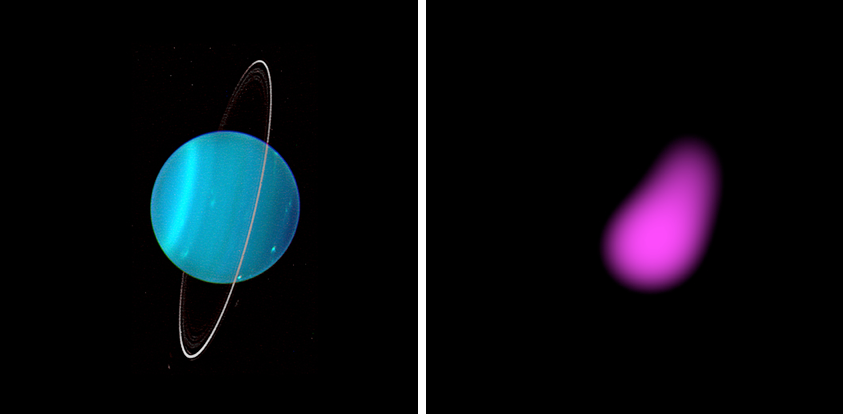

The second 2021 composite image, shown below, was created from a Keck optical image and X-ray images made with Chandra’s High Resolution Camera (HRC) during observations on 11 and 12 November 2017. The HRC is sensitive to softer X-ray emissions (down to 0.06 keV, 20.7 nm) than ACIS, enabling it to collect more photons in the 0.1–1.2 keV (12.4 to 0.1 nm) range most important for planetary studies. The authors report, ”These fluxes exceed expectations from scattered solar emission alone, suggesting either a larger X-ray albedo than Jupiter/Saturn or the possibility of additional X-ray production processes at Uranus.”
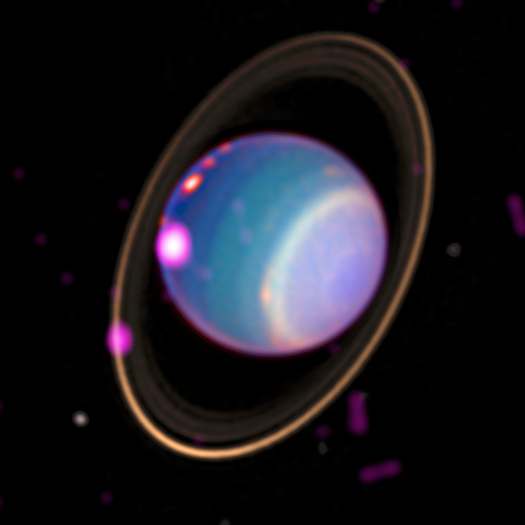
Sources: X-ray: NASA/CXO/University College London/W. Dunn
et al; Optical: W.M. Keck Observatory
The authors conclude by noting that, “Further, and longer, observations with Chandra would help to produce a map of X-ray emission across Uranus and to identify, with better signal-to-noise, the source locations for the X-rays, constraining possible contributions from the rings and aurora…… However, the current generation of X-ray observatories does not provide sufficient sensitivity to spectrally characterize the short interval temporal fluctuation observed in the November 12, 2017 observation.”
New space-based X-ray observational capabilities are being developed by NASA and the European Space Agency (ESA), but won’t be operational for a decade or more:
- NASA’s Lynx next-generation X-ray observatory: https://wwwastro.msfc.nasa.gov/lynx/
- ESA’s Athena (Advanced Telescope for High ENergy Astrophysics) orbital X-ray observatory: https://www.the-athena-x-ray-observatory.eu
3. 2023 JWST near-infrared images of Uranus
The James Webb Space Telescope (JWST), which has four science instruments designed to observe at optical to mid-infrared (0.6 – 28.3 microns) wavelengths, produced its first images of Uranus in April 2023.
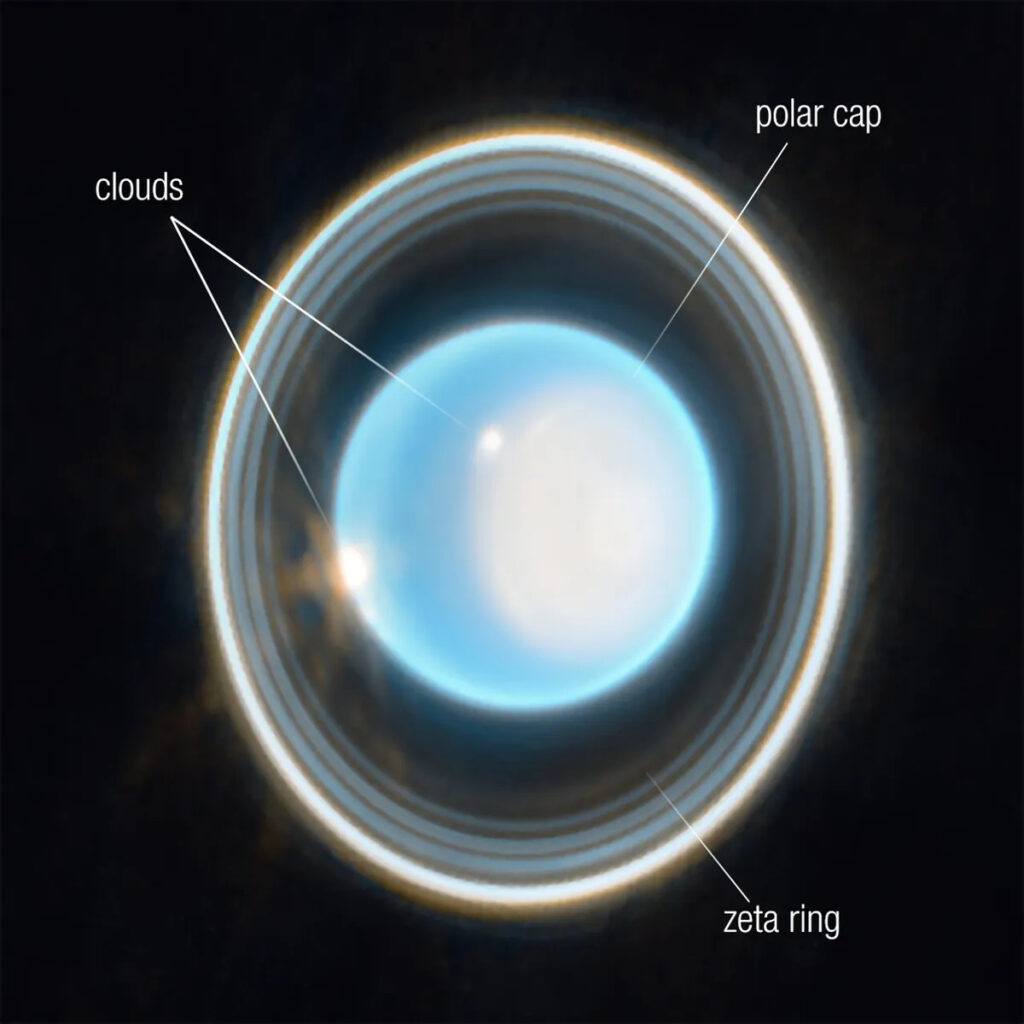
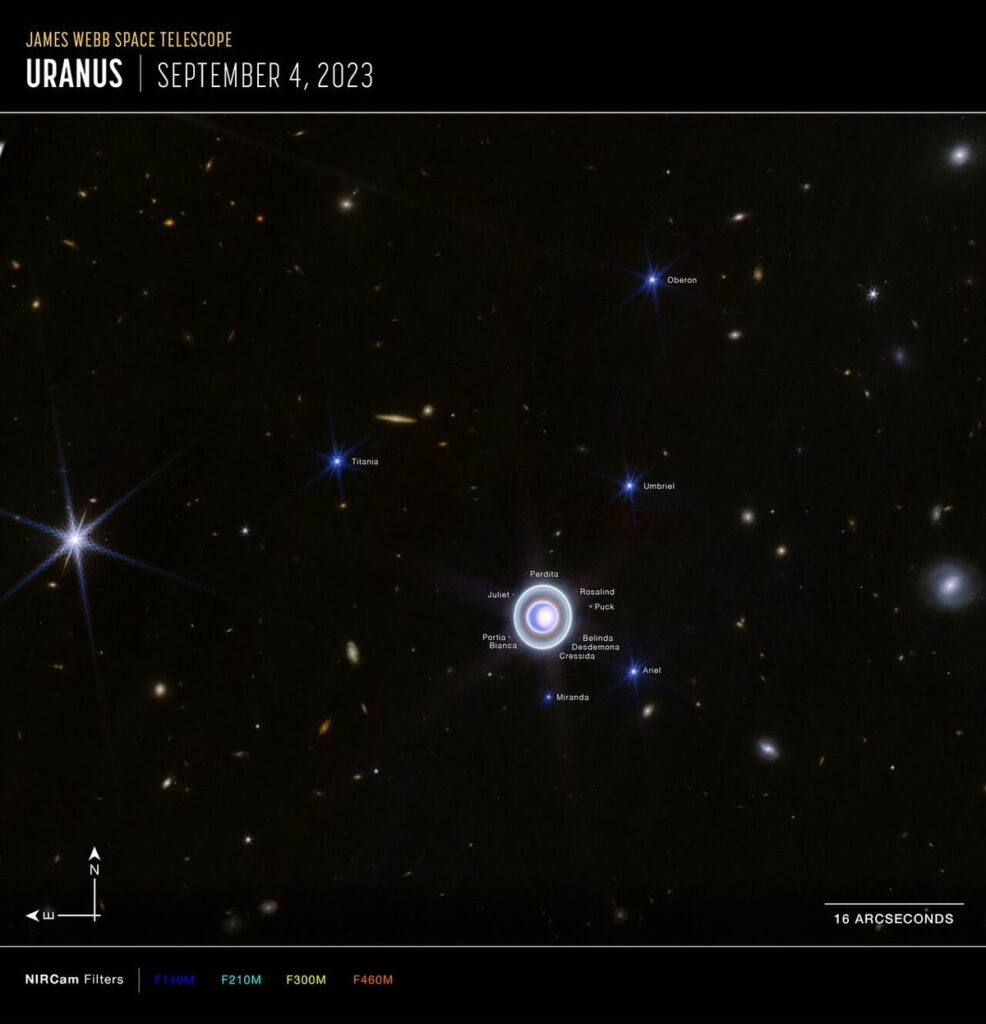
Wide field image of Uranus captured by the JWST on 6 Feb. 2023 at near-infrared wavelengths of 1.4 to 5.0 microns. Note that 14 of the 27 known moons are identified in the image. Also note the many distant galaxies in this image. Sources: NASA, ESA, CSA, STScI
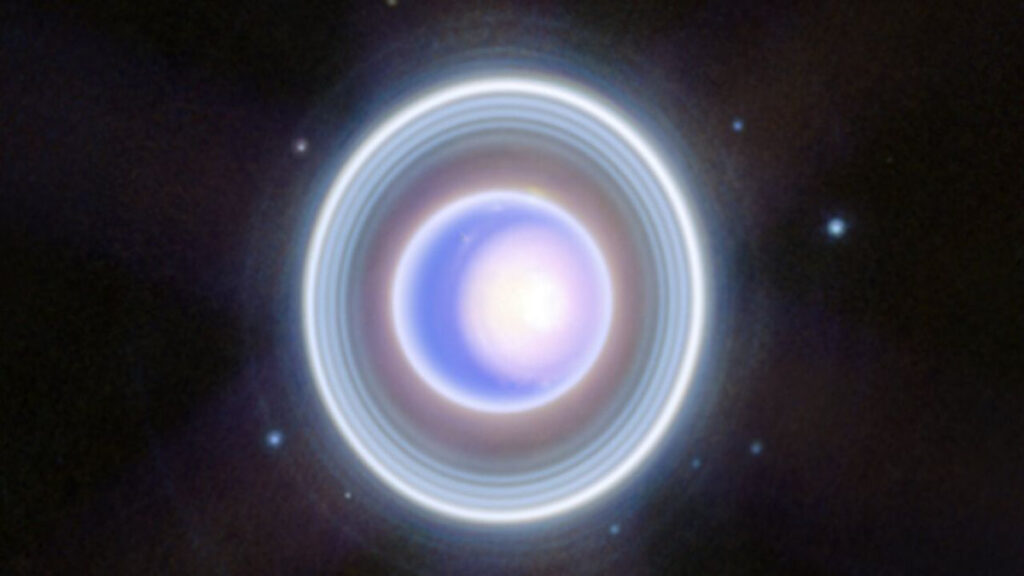
Enlarged view of the 6 Feb. 2023 JWST near-infrared image shows the bright North polar cap, glowing clouds, details of the ring structure and many of the inner moons. Sources: NASA, ESA, CSA, STScI
4. For more information:
- “Uranus: First X-rays From Uranus Discovered,” NASA, Chandra X-Ray Observatory, 31 March 2021: https://www.nasa.gov/mission_pages/chandra/images/first-x-rays-from-uranus-discovered.html
- W. R. Dunn, et al., “A Low Signal Detection of X‐Rays From Uranus,” Journal of Geophysical Research, 31 March 2021: https://agupubs.onlinelibrary.wiley.com/doi/10.1029/2020JA028739
- “Exploring The Invisible Universe: The Chandra X-ray Observatory,” NASA Fact Sheet number: FS-1999-08-112-MSFC, August 1999: https://www.nasa.gov/centers/marshall/news/background/facts/axafnew.html
- “The Keck Observatory: Portal to the Universe,” Keck Observatory: https://www.keckobservatory.org/wp-content/uploads/2017/09/Finalpdf4onlinepostingSTRPLN.pdf
- Robert Lea, “Rings around Uranus! James Webb Space Telescope captures stunning image of ice giant, Space.com, 6 April 2023: https://www.space.com/james-webb-space-telescope-uranus-rings-photo
- Keith Cooper, “The rings of Uranus look positively festive in epic James Webb Space Telescope holiday photo,” Space.com, 18 December 2023: https://www.space.com/uranus-rings-james-webb-space-telescope-holiday-photo